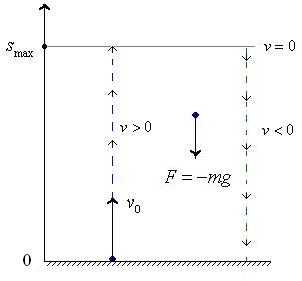| Introduction |
Basic Conceptions
| First-Order Differential Equations |
Directly Integrable Equations
Motion of a Body - Problem 1
Motion of a Body - Problem 2
Motion of a Body - Problem 3
The Spontaneous Radioactive of Substance
Separable Equations
Motion of Particals in Viscous Fluid
Newton's Model of Cooling
Model of Population
Separable Equations
Motion of Particals in Viscous Fluid
Newton's Model of Cooling
Model of Population
Homogeneous Equations
Linear Equations
Bernoulli Equations
Exact Differential Equations
| Differential Equations of Higher Orders |
Basic Conceptions
Equations of Special Kinds
Some Graphic Illustrations using MATLAB
| Real-Life Problems:
Motion of a Body - Problem 1 |
The Newton's law of motion equates the time rate of change of particle momentum p = m v and the resultant force F applied to the particle:
Let us consider a motion of a body thrown straight upward with a velocity v0.
 .
.
Then integration yields the general solution:
v(t)
= –g t +C.
Substitution of t = 0 gives the value of
the constant of integration:
C = v(0) = v0.
Thus, we obtain the particular solution:
v(t)
= v0 –
g t.
The body reaches its maximum height when v(t)
= 0, that is, at the time point
t = v0
/ g.
Graphic Illustrations Using MATLAB.
|
|
